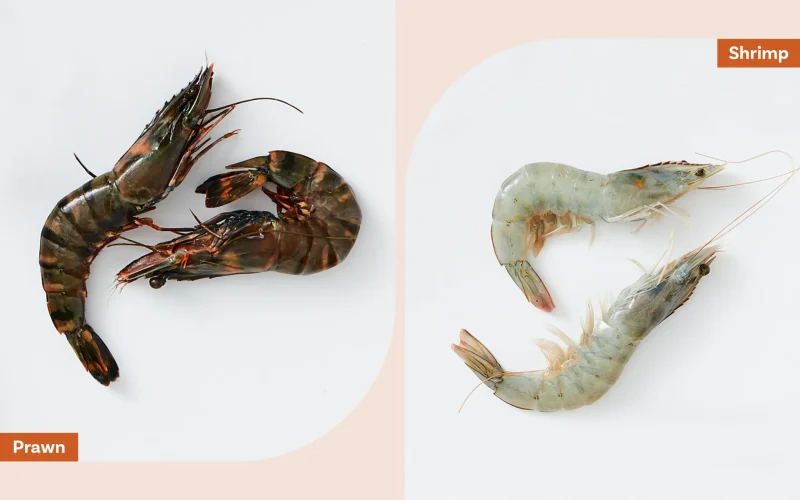Shrimp and prawns are perhaps the most popular seafood when it comes to cooking and eating.
They are simple to obtain for the home cook and can be purchased fresh or frozen, raw or cooked, and even peeled or shelled.
These crustaceans are incredibly delectable when cooked in various ways, making them one of the most popular seafood worldwide.
They range in size from tiny small bay shrimp that can fit on a spoon to massive tiger prawns that can weigh up to half a pound or more.
The terms shrimp and prawn are frequently used interchangeably on menus and in conversation, and it’s simple to see why.
They are virtually indistinguishable in terms of appearance and flavor.
Even though the terms shrimp and prawn are often used interchangeably in many regions, there must be a clear distinction between the two.
However, in some countries, especially in the United Kingdom and certain parts of Europe, there is a perceived “difference between shrimp and prawn.”
However, shrimp and prawns are two different species, and while they are both delicious and highly similar, there are certain distinctions that distinguish them. So, how can you tell them apart?
Here are a few general features that are sometimes suggested that notable differentiate shrimp and prawns, but remember that these are not strict rules and may not be applicable in all cases:
Size
Keep in mind that the size of a shrimp or prawn is not necessarily an accurate indicator.
Depending on the species, both can vary in size. There is no conventional size that makes a difference.
However, crustaceans are often classified by count per pound. Size is a useful way to tell the difference between the two.
In some regions, people use the term “shrimp for smaller species and “prawn” for larger ones.
However, this is inconsistent globally, and the size difference can vary widely.
Check the shell if you want to know what crustacean you bought without going out on a shrimp boat.
Legs and Claws
Some people and some countries suggest that prawns have longer legs in relation to their body size and more enormous claws than shrimp.
This feature can be a reliable way to know the difference between shrimp and prawns.
Shrimp and prawns are both ten-legged invertebrates. Their legs, however, differ slightly from one another. Shrimp have one pair of legs with claws at the end, but prawns have three pairs.
Habitat
There is also a notion about the differences between shrimp and prawns: prawns live in freshwater, while shrimp live in saltwater.
This is only sometimes the case, as there are freshwater shrimp and saltwater prawns.
When it comes to the culinary crustaceans, you’re likely to buy at your local fish market or order at your favorite seafood restaurant.
The majority of the shrimp you buy will come from saltwater, while the majority of the prawns will come from freshwater.
Body Shape
Some claim that prawns have a more elongated body shape than shrimp’s curved or shorter body. However, this generalization might only hold for some species.
Gill Structure
Another supposed difference between shrimp and prawns is in the gill structure. Prawns are said to have branching gills, while shrimp have lamellar (plate-like) gills.
However, this is a more technical detail and not easily observed in everyday situations or by a lame man.
Culinary Use
In some culinary traditions, the terms “shrimp” and “prawn” may be used to distinguish between different species used in cooking.
For example, the term “shrimp” is commonly used in the United States, while “prawn” is more prevalent in the United Kingdom.
However, this is a cultural and linguistic difference rather than a biological one.
Shell Structure
The structure of the shell in shrimp and prawns varies as a result of their flexible structure.
Shrimp are bendier than prawns, whereas prawns have overlapping segments and less movement.
Some people claim that prawns have a more rigid surface than shrimp. However, the hardness of the body can also vary among species.
Geographical Variation
The usage of the terms can vary widely based on geographical location. In some regions, the words are used interchangeably, while in others, there may be specific cultural or linguistic preferences for one term over the other.
Antennae Length
Another difference between shrimp and prawns is the length of the antennae. Prawns are said to have longer antennae compared to shrimp. However, this can be a subtle difference.
Coloration
The colors of shrimp and prawns can vary widely. Although no consistent color differentiates them universally from one another, they tend to exhibit a range of colors, including brown, white, pink, and others.
Behavioural Differences
Some marine biologists suggest that there can be a behavioral difference between these two crustaceans, with prawns being more aggressive.
This difference can be applicable but might not be easily observed by a random person.
Taxonomic Classification
From a taxonomic standpoint, shrimp and prawns belong to the suborder Natantia in the order Decapoda, which encompasses crustaceans with ten legs.
The distinction between the two is only sometimes clear-cut and can be challenging, as these groups have considerable diversity.
Economic Importance
A less significant difference between shrimp and prawn is in its economic value.
However, they are both essential seafood species globally. They are harvested for human consumption and contribute significantly to the fishing industry.
Still, there is a slight difference in their price in a few places, especially with people who can tell their differences by size or weight.
Method of farming
The methods of farming and catching shrimp and prawns also can vary, but both are valued for their taste and nutritional content.
Culinary Preparation
While there might not be strict biological differences, some chefs and culinary enthusiasts argue that there are textural and flavor distinctions between shrimp and prawns, claiming that apart from prawns being larger than shrimp, they often taste sweeter
However, these differences are often subjective and depend on various factors such as the specific species, preparation methods, and personal taste preferences. However, there can still be a notable difference.
Species Diversity
Shrimp and prawns encompass a wide variety of species, each with unique characteristics.
The diversity within these groups can make it challenging to establish clear-cut distinctions, and variations in size, color, and morphology are considerable.
Life Cycle
Another difference between shrimp and prawns is in the life cycle.
Shrimp and prawns undergo a process known as metamorphosis as part of their life cycle.
The larval stages, often called nauplii and zoea, are distinct for shrimp and prawns, but the differences can be subtle and may require microscopic examination for precise identification.
Global Distribution
Shrimp and prawns are found in diverse aquatic environments around the world.
The distribution of specific species can be influenced by temperature, salinity, and substrate.
Some species may adapt more to tropical waters, while others thrive in colder or temperate regions.
Social Behavior
The social behavior between the two crustaceans is also a notable difference to note.
While shrimp and prawns can exhibit social behavior, the specifics can vary among species.
Some live in colonies, while others are more solitary. The social dynamics can be influenced by factors such as food availability, predation pressure, and environmental conditions.
Molting Process
Shrimp and prawns, like other crustaceans, undergo molting, a process where they shed their exoskeleton to grow.
However, the frequency and details of the molting process can vary among species of shrimp and prawns, and the size of the crustacean may increase significantly after molting.
Feeding Habits
The feeding habits of shrimp and prawns are omnivores, feeding on various organic matter, including algae, plankton, detritus, and tiny aquatic organisms.
However, feeding habits are different among specific species. Some are scavengers, while others are more active hunters.
Reproductive Strategies
Reproductive strategies can be a difference between shrimp and prawns.
Some may have complex courtship rituals, while others may have more straightforward mating behaviors.
The number of eggs produced, the care given to offspring, and the duration of the reproductive process can vary widely between species of prawn and shrimp.
Temperature Tolerance
Shrimp and prawns exhibit varying degrees of temperature tolerance, which is a difference between them.
Some species adapt to warmer tropical waters, while others thrive in colder or temperate environments. Temperature preferences can influence their geographical distribution.
Long-Distance Migration
Certain shrimp species, such as the Christmas Island red crab, undertake remarkable long-distance migrations.
Specific environmental cues, such as lunar phases or seasonal changes, often trigger these migrations. Thus, long-distance migration is a difference.
Conclusion
Although we have listed above the common and common differences between shrimp and prawns, their similarities cannot be ignored, such as their ecological Importance, symbiotic relation, bioluminescence, and so on.
Also, remember that these distinctions between shrimp and prawn are often subtle, and the terms “shrimp” and “prawn” are used differently in various parts of the world.
In many cases, the term choice is more about cultural and regional linguistic conventions than strict biological differences.
If you’re dealing with a specific species, using the scientific or common name is often more accurate to avoid confusion.








